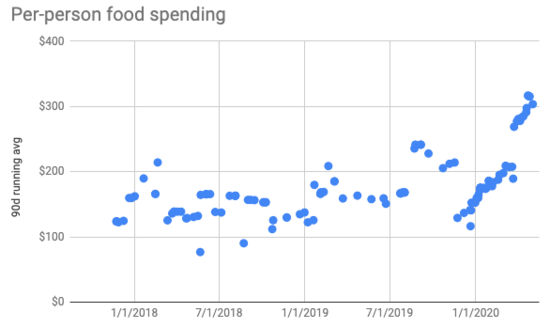Our house has shared groceries, and in my most recent reconcile I saw that our spending is up quite a bit relative to this time last year. In 2019, April through July, our monthly spending per person was $172, while in 2020 it was $303. In the big picture this is due to the pandemic, but I'm not sure which factors are responsible for most of the change. Some ideas:
Our house is not going into stores, and we've been having groceries delivered. This reduces our risk, but it's also somewhat better at limiting spread in general. Grocery delivery is more expensive, especially when you include the tips. I expect this is the largest component for us.
[EDIT: Julia points out that another reason Instacart is more expensive is that we're generally choosing the cheapest option for things, and so when they make substitutions they're picking more expensive versions or generally not predicting our preferences very well.]
Food has gotten more expensive, but only by ~3%: CPIFABSL is up to 269 from 261 in February.
I'm not eating lunch at work, since the office is closed. I also used to eat my fruits and vegetables there, and they're more expensive than the mostly carbs I used to eat at home.
People in the house aren't eating out anymore. I don't think any of us were eating that many other commercially prepared meals, but it's a component. The house grocery budget won't count a restaurant meal, but it will count the food you eat at home because you didn't go out to eat.
I used to also buy things when they were on sale, and without walking through the grocery store that doesn't really work anymore.
We've been buying some things from a restaurant supply place, and while for some products it is substantially cheaper, others are fancier than what we would normally buy. I suspect this one about cancels out.
It's very noisy, but here's a chart showing our historical food spending. It's a 90 day running average, so the recent rising slope is mostly the step-change of our newer more expensive situation being smeared over a longer period.

Are you all maybe storing more dry goods? Our spending on groceries doubled in the first three months of lockdown, but is only about 1.5x over March-July of last year (partly because we do eat at restaurants), and part of that is that we've been buying things much more in bulk (to avoid delivery fees/delays and because sometimes that's all you can find). That will pay off over time, but it's just starting and we're definitely carrying more "inventory" right now than usual. (We count paper products/aluminum foil/etc in groceries, and it's an especially strong effect in that sub-category).
Also, are people treating themselves to more expensive ingredients more often, to make up for other luxuries they can't have during COVID? We've been buying fancier ingredients and making more treat foods partly because we can't get them at restaurants and partly because it's a nice COVID-safe fun activity. Relatedly, there are some things I'm making from scratch for fun/to have fresh without frequent deliveries, like breads and ginger beer, that are surprisingly often more expensive to make from scratch than just to buy commercially (and that difference should really be chalked up to an "entertainment" budget, not groceries)
I don't think we're stocking up more now than we were before: we already had an approach of stocking up non-perishables pretty substantially, and while we ran our stocks down a bit in the first couple months of the lockdown we've since replenished back to approximately where we were.
I'm quite surprised that you've found making bread and ginger beer at home to be more expensive than buying them. Bread, for example, is essentially flour, water, yeast, and salt. That should come to 30¢-70¢/lb, depending on how cheaply you can get flour, while commercially produced bread is typically twice that.